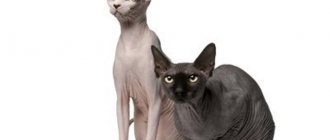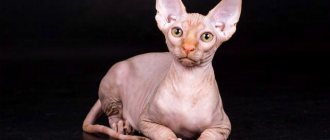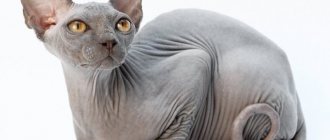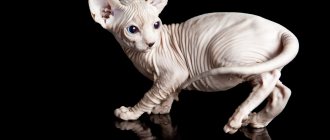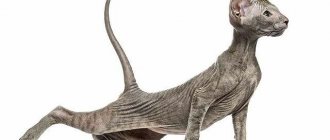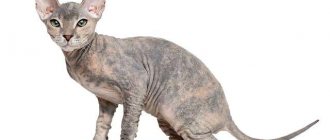Home page Attractions
103 951 4.37 20
For many millennia, the Egyptian Sphinx has been guarding the tombs of the pharaohs - and some even claim that it appeared long before the construction of the most luxurious tombs of the ancient world and survived the global flood. This amazing beast cares not only about the safety of the deceased pharaohs: after all, in reality he is alive, he is a demigod, he is a guardian of order.
Therefore, the sphinx does not always sit in its place: if it is not satisfied with the way people behave (wars, strife, robberies, passion for foreign gods), it jumps off the pedestal and runs away into the desert. And there, buried deep in the sand, it disappears from sight for a long time.
History of the Canadian Sphynx breed
Canadian Sphynx
Although the breed is quite young, the existence of hairless cats is mentioned in the annals of various civilizations. The thing is that “bald” offspring can appear from completely ordinary parents as a result of a natural mutation. Most often, such animals were considered an anomaly and were discarded by humans.
There is evidence of the emergence in South America of an entire population of graceful creatures with amber-colored eyes. True, unlike Canadians, they could be partially covered with wool during the cold season, and wore mustaches all year round. It is impossible to judge the genetic characteristics of these animals today, since the breed has disappeared. The last individuals whose existence is documented lived in the 20s of the last century, but then “Inca cats,” as the Mexicans called them, did not interest professional breeders.
40 years have passed, and much further north, in the Canadian province of Ontario, the owner of a black and white short-haired cat named Elizabeth was surprised to find an unusual specimen in her pet’s litter. The kitten was given the name Prune (English: Prune) and, upon reaching maturity, was crossed with its own mother. The first experiments seemed successful, but already in the early 1970s the line was interrupted.
Around the same time, a new stage in the history of the breed began. In one of the catteries in Baden, Minnesota, two cats were devoid of fur at once. All modern elite lines trace their pedigree back to them, although the selection process, of course, included cats of different breeds. The best results were achieved by working with Devon Rexes; “naked” kittens, which were again discovered among our northern neighbors, actively participated in the creation of the breed. They were originally called “Canadian hairless cats,” but enthusiasts wanted something more sonorous and drew parallels with the oldest surviving monumental sculpture - the Egyptian Great Sphinx, which guards the peace of ancient rulers in Giza.
Recognition from international felinological organizations did not come immediately. There were concerns that the mutation was causing serious health problems. When time showed the inconsistency of these theories, The International Cat Organization (TICA) was the first to allow Sphynx dogs to participate in its exhibitions in 1986. After 6 years, champion status was received from the Canadian Cat Association (CCA), but the breed standard according to the authoritative The Cat Fanciers' Association (CFA) was approved relatively recently, in 2002.
How M. Lehner guessed who the Great Sphinx of Egypt depicts
Excavations of the Temple of Khafre (foreground).
The Kheop Pyramid is in the background. Photo by Henri Bechard, 1887 The tombs of the pharaohs change their shape and size over time. Mastabas and pyramids appear. And the Great Sphinx is the only one.
A significant number of Egyptologists believe that he represents Pharaoh Khafre (Hawr) from the fourth dynasty, because. a similar small stone silhouette with his face was found nearby. The sizes of the blocks of Khafre's tomb (circa 2540 BC) and the monster also match. Despite their claims, no one knows for sure when and by whom this statue was installed in Giza.
Mark Lehner found the answer to this question. He studied the structure of the Sphinx Temple, which is located 9 meters away. On the days of the spring and autumn equinox, the sun at sunset connects the two sanctuaries of the temple and the pyramid of Khafre with one line.
The religion of the ancient Egyptian kingdom was based on the worship of the Sun. Local residents worshiped the idol as an incarnation of the Sun God, calling it Khor-Em-Akhet. Comparing these facts, Mark determines the original purpose of the Sphinx and its identity: the face of Khafre, the son of Cheops, looks out from the figure of a god who protects the pharaoh's journey to the afterlife, making it safe.
In 1996, a New York detective and identification expert revealed that the resemblance was more noticeable to Khafre's older brother Djedefre (or son, according to other sources). The debate on this topic is still ongoing.
Appearance of the Sphinx
Sphynx kittens
Sphynxes are not large breeds. Females usually weigh 3.5-4 kg, males weigh between 5-7 kg. At the same time, the body is muscular and dense, which is why cats actually turn out to be heavier than one might expect given their size. The skin is thick and gathers into characteristic folds, especially pronounced on the muzzle.
Head
Medium in size, shaped like a slightly rounded modified wedge, where the length is slightly greater than the width. The forehead is flat, the transition from it to the muzzle can be either quite soft or clearly pronounced. The muzzle is short. The cheekbones are high and clearly defined. The chin is strong and forms a perpendicular to the upper lip. The nose is short, with a slight to medium stop. The whisker pads are well developed, although the whiskers themselves are completely or almost completely absent.
Ears
Ears are one of the distinctive features of the Canadian Sphynx breed. Very large compared to the head. Upright and open. The base is wide. The inner surface is without wool.
Eyes
The eyes of sphinxes are large, shaped like a lemon, because with a wide middle part they narrow equally on both sides. Set wide and slightly slanted. The color is not regulated, but must be in harmony with the color.
Neck
Medium length, slightly arched, with well-developed muscles.
Face of the Canadian Sphynx
Body
Sphynx paws
The body of the sphinx is of medium length, muscular. The chest is wide and rounded. The belly is round and full. The back of the body is rounded.
Legs
Medium length, proportional to the body. Strong and muscular. The hind ones are slightly longer than the front ones.
Paws
Oval, with thick pads and well-developed long toes.
Tail
White Sphynx
The length of the Sphynx's tail is proportional to its body. Graceful and flexible, gradually tapering from base to tip.
Cover and skin
The skin of the Canadian Sphynx is thick and forms folds, which are especially numerous on the face and legs. They seem completely hairless, but usually the body is covered with delicate down (a length of no more than 2 mm is allowed). The norm is the presence of short, sparse hair on the outside of the ears, tail, between the toes and in the scrotum area. The bridge of the nose is covered with the usual short hair for cats.
Color
Despite the lack of hair in the usual sense, sphinxes have many colors: white, black, red, chocolate, lilac (lavender), tabby, tortoiseshell, two-color, calico (tri-color), color point, mink. Neither conflicts with the CFA standard.
Born of Typhon and Echidna
The Greeks adopted the image of an unusual creature from the Egyptians, but gave it a completely different meaning. The Sphinx, one of the monstrous creatures of the world, in ancient Greek myths appears as the child of Typhon and Echidna.
Typhon and Echidna are mythical chthonic (representing wild nature) monsters.
Typhon, a monster with hundreds of dragon heads, is the son of the Earth goddess Gaia and Tartarus, the patron saint of volcanic eruptions and underground elements.
Echidna is a half-woman, half-snake, also the daughter of Gaia and Tartarus and, accordingly, is the sister of her husband Typhon. The monstrous couple gave birth to such terrible demons and monsters as:
— Sphinx and Chimera;
— Lernaean Hydra and Nemean Lion;
- Cerberus and Orff.
The Sphinx is endowed with the features of several living creatures: the body of a lion, the wings of a bird of prey, the tail of a bull and a human head.
Photo of the Canadian Sphynx
The character of the Canadian Sphynx
The ancient sculpture of a lion with a human head, lost in the African sands, was once called differently by Arabic speakers - Abu al-Haul, that is, the Father of Terror. But her little namesakes don’t seem at all intimidating to their owners. These are real “tails” that will follow a person everywhere and will not miss the opportunity to settle on his lap.
This sphinx has found its place
However, such affection is not at all an indicator of laziness. Sphinxes are very mischievous and playful creatures; they get involved in active fun with great excitement or independently come up with entertainment for themselves, such as “hunting” for a beetle that happens to be in the apartment. Games should be versatile and challenge not only dexterity and muscle strength, but also the intellect.
Sphinxes do not tolerate loneliness well, which should be taken into account by potential owners whose work involves frequent and long business trips. Canadians are attached not to a place, but to “their” people, so separation is a difficult test for them, even if in your absence the care of your pet is entrusted to reliable and kind hands.
Sphynxes are absolutely not aggressive, so they get along well with children of different ages and calmly share their home with other pets. Moreover, they know how to be friends with both cats and dogs, which helps brighten up the long hours of waiting to meet a person.
Representatives of this breed get used to being in large crowds of people quite easily. Thanks to this, sphinxes feel good at exhibitions, and some bring the skill of equanimity to such a level that they become real movie stars. The most striking example of this is Ted Nugent, who played the role of Mr. Bigglesworth, Dr. Evil's cat from the famous Austin Powers film series.
Little-known facts about the Sphinx
It goes without saying that such an amazing statue will raise a lot of questions, theories and all kinds of assumptions, and we will now introduce you to the most popular of them in our article.
Buried in the sand
For a long time it was believed that only the head remained of the Sphinx. Presumably, this happened after the fragmentation of united Egypt and the subsequent conquests of the country by new conquerors. Only in 1925 was the Sphinx completely cleared of sand, and Napoleon, who arrived in Egypt in 1798, saw only its head. According to legend, it was on his order that the figure’s nose was shot down by a cannon shot.
Nasal deprivation
We all know that the modern Great Sphinx is noseless. Initially, this act was attributed to Napoleon, but many sources say that the Sphinx lost its nose long before the French emperor.
Care and maintenance
Having no hair may seem like a big advantage to a busy owner, but in fact, Sphynx cats require even more care than their furry counterparts. The sweat and sebaceous glands in these cats work in “normal mode”, so a kind of plaque forms on the surface of the skin, which provokes the appearance of greasy stains on the owners’ clothes, bedding and upholstery.
Canadian Sphynx in a sweater
To avoid this, hygiene procedures should be carried out regularly. Some people think that it is enough to wipe the cat’s body with wet wipes that do not contain alcohol or fragrances. But most agree that the optimal solution to the problem is weekly bathing with special mild products or baby shampoo. If you accustom a kitten to them from an early age, the process will happen quickly and without much hassle. Please note that immediately after a bath the sphinx must be wrapped in a towel!
The issue of hypothermia is generally quite acute for representatives of this breed. When you hold a hairless cat in your arms, it seems really hot. The fact is that due to the lack of a fur “buffer”, heat exchange with the external environment is much more active in them than in other animals. This means that in a cool room the sphinx will freeze no less than a naked person, so buying special clothes for winter and the off-season will not be superfluous even for permanent residents of city apartments.
By the way, experienced breeders recommend exclusively keeping Canadian Sphynxes at home. If you consider it necessary for your pet to stay in the fresh air, it is better to limit its duration and monitor the cat at all times. Independent walks are contraindicated not only because of the risk of colds or sunburn (yes, Sphynx cats can get tanned and burn, so in the summer they need sunscreen!). Thanks to its characteristic appearance, even a layman can easily recognize your pet as a purebred, which means a potentially expensive animal, which can lead to kidnapping.
We didn't find a house and organized it ourselves
Other care tips differ little from the standard ones. It is important to monitor the condition of the eyes and ears to avoid infections. Regular brushing of your teeth with a special paste guarantees protection from tartar, and trimming your nails will help keep your furniture and walls in their original condition.
The cat will be grateful for a personal “house” with the opportunity to climb higher and play hide and seek, but most sphinxes prefer the owner’s bed, where you can comfortably sit under a warm blanket, to a soft bed.
All sphinxes have an excellent appetite. This is another side effect of not having fur, as they require more energy than other cats due to their intense heat exchange. The main thing is that the quality of the food is at a high level and fully satisfies your pet’s needs for proteins, fats, carbohydrates, vitamins and minerals. The easiest way to achieve this balance is with specialized premium and super premium food. But if you are willing to spend time creating a healthy menu of foods, natural nutrition will be a worthy alternative.
Leftovers are sweet
Canadian Sphynx having a meal
Recommended by topic
Aphrodite Medusa Gorgon Zeus
Actually, the head of the Sphinx bears an incredible resemblance to Pharaoh Khafre, which is why the legend began that the Sphinx was built at the same time as the great pyramids of Giza. The statue reaches 73 meters in length and 20 meters in height. It was believed that between the front paws of the Sphinx there was a sanctuary related to the cult of Ra.
The official version says that the statue depicted the power of the pharaoh, because. It has long been believed that the lion is the embodiment of the power of the sun god. To this day, images of pharaohs in the form of a lion destroying their enemies are found in tombs. For a long time, the sculpture was dedicated specifically to the god Ra, but later it began to be identified with Horemakhet. Subsequently, Amenhotep 2 dedicated a special temple to the Sphinx, located near the pyramid complex.
Sphinx is a Greek word meaning strangler. What the mysterious creature’s actual name was is still unknown, because we still don’t know what the ancient Egyptian language actually sounded like.
As for the meaning of the Great Sphinx, then everything is not clear. So far, official science can only state with certainty that the statue had more psychological and ritual significance. People believed that the Sphinx should protect the peace in the valley of the pharaohs of Egypt, the peace of the pyramids. It was believed that in his stone form he simply slept, and woke up every time someone disturbed the peace of the tombs of the pharaohs.
Between the Sphinx's paws is a granite stele that tells an interesting story. It is known that the Sphinx was saved from complete destruction only by the sands that covered it. And the stele says that Pharaoh Thutmose 4, when he was still a prince, had a dream while hunting. In it, the deity informed him of the location of his body, hidden under the sands of the desert, and asked him to dig it up.
In return, the deity promised Thutmose the coveted crown and throne of the pharaoh. Thutmose fulfilled the deity's request. Moreover, he built a brick wall around the statue, sections of which were found only in 2010. It is still unclear how large the wall was, but archaeologists have excavated an area 132 meters long.
Health and illness of the Sphinx
Cute sphinx
In general, with the right diet and proper care, sphinxes are infrequent patients of veterinary clinics. Problems can be caused by hypothermia, prolonged exposure to the sun, neglect of hygiene rules on the part of the owners, and lack of immunity due to missed vaccinations.
But there are also breed-specific diseases. The weak point of Canadians is sensitive skin; it can be affected by urticaria pigmentosa. Redness and rashes on the body can also be symptoms of allergies, including food allergies. Only a doctor can determine the exact cause and prescribe treatment based on test results.
Like Maine Coons, Sphynx cats suffer from hypertrophic cardiomyopathy. This dangerous heart disease is caused by a genetic mutation, but to date there is no convincing evidence that heredity has a decisive influence on its development.
But another disease of sphinxes, myopathy, is transmitted to descendants from parents. They got it in the process of selective work with Devon Rex. Progressive muscle dysfunction has no cure, progresses individually and often leads to death as a result of laryngospasms. Usually appears at 4-7 weeks of age, but may be asymptomatic until 12-14 weeks. The nursery must warn you if the kitten is at risk.
Brief description of the Sphinx in Egypt
Sphinx and 50 jets
Great Sphinx.
Egypt Author: Most likely Hamish2k, the first uploader - Most likely Hamish2k, the first uploader, CC BY-SA 3.0, Link The Sphinx in Egypt is the most grandiose surviving sculpture of antiquity. The length of the body is 3 compartment cars (73.5 m), and the height is a 6-story building (20 m). The bus is smaller than one front paw. And the weight of 50 jet airliners is equal to the weight of a giant.
The blocks from which the paws are made were added during the New Kingdom period to restore the original appearance. The sacred Cobra, nose and ritual beard - symbols of the power of the pharaohs - are missing. Fragments of the latter are on display in the British Museum.
Remnants of the original dark red paint can be seen near the ear.
What could the strange proportions mean?
One of the main abnormalities of the figure is the disproportion of the head and torso. It appears that the upper part was rebuilt several times by subsequent rulers. There are opinions that at first the head of the idol was either a ram or a falcon and later turned into a human form. Restorations and renovations over many thousands of years could reduce the head or enlarge the body.
Where is the Sphinx?
The monument is located in the necropolis of Memphis next to the pyramidal structures of Khufu (Cheops), Khafre (Chephren) and Menkaure (Mycerinus) about 10 km from Cairo, on the western bank of the Nile River on the Giza Plateau.
How to choose a kitten
The main advice is the same for all purebred animals: do not try to save money on your purchase by going to the “bird market” or responding to a random ad. Only the best nurseries and breeders with an impeccable reputation will guarantee that you will receive a healthy pet, the origin of which cannot be doubted. After all, the Canadian Sphynx is not just a lack of hair, but a graceful, beautifully built, affectionate and intelligent creature that will live next to you for the next few years.
If you do not plan to participate in exhibitions, it is enough to make sure that the chosen baby is healthy and active, easily makes contact with people, without showing fear or aggression. The rest will be determined by the available documents (pedigree, veterinarian’s report, vaccination card). We recommend getting to know the parents and looking at the living conditions - they will say a lot about the breeder’s attitude towards the cats.
Unraveling the secret of construction: interesting facts
The world's leading Egyptologist Mark Lehner spent 5 years next to the mysterious creature, studying him, the materials and rock around him. He compiled a detailed map of the statue and came to a clear conclusion: the statue was carved from limestone, which lies at the base of the Giza plateau.
First, they hollowed out a trench in the shape of a horseshoe, leaving a huge block in the center. And then the sculptors carved a monument out of it. Blocks weighing up to 100 tons for the construction of the walls of the temple in front of the Sphinx were taken from here.
But this is only part of the solution. The other is how exactly did they do it?
Together with Rick Brown, an expert on ancient tools, Mark reproduced the tools depicted in tomb drawings that were over 4,000 years old. These were copper chisels, a two-handed pestle and a hammer. Then, with these tools, they cut out a detail of the monument from the limestone block: the missing nose.
This experiment made it possible to calculate that one hundred sculptors could have worked on the creation of the mysterious figure for three years. At the same time, they were accompanied by a whole army of workers who created tools, hauled away rock and did other necessary work.
Photo of the Canadian Sphynx
How much does a Sphynx cost?
If you are offered to buy a Sphynx kitten for 3-4 thousand rubles, you can rest assured that there can be no talk of any pedigree here.
The price of kittens in trusted nurseries starts from 8-10 thousand rubles. Children who have more or less significant deviations from the breed standard are cheaper. They are perfect for those who dream of a pet with an extraordinary appearance and character.
Prospective exhibitors whose parents can boast of championship titles and other titles will cost their future owners at least 15 thousand rubles.
How old is the giant anyway? Writer vs. Scientists
Researcher John Anthony West
There is currently a lively debate over the dating of the monument. Writer John Anthony West was the first to notice signs of water erosion on the lion's body. Other structures on the plateau show wind or sand erosion. He contacted geologist and associate professor at Boston University Robert M. Schoch, who, after studying the materials, agreed with West's conclusions. In 1993, their joint work “The Secret of the Sphinx” was presented, which received an Emmy Award for Best Research and a nomination for Best Documentary.
Although today this area is arid, about 10,000 years ago the climate there was humid and rainy. West and Schoch concluded that the Sphinx would have to be between 7,000 and 10,000 years old to produce the observed effects of water erosion.
Scientists have rejected Schoch's theory as wildly flawed, pointing out that the once common violent rain storms across Egypt had ceased before the sculpture's appearance. But the question remains: why was it only this Giza structure that showed signs of water damage?


